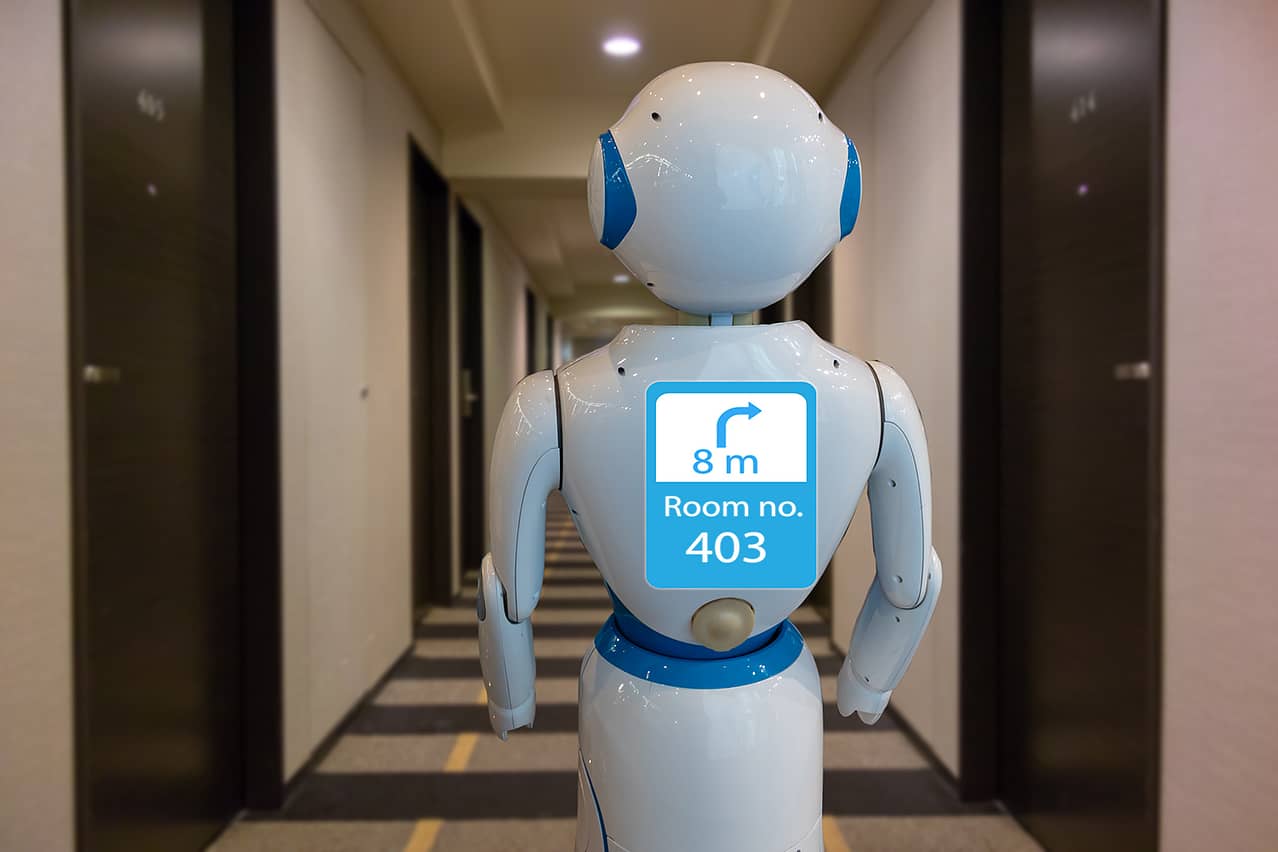
By Veronica Givone | Managing Director, Hospitality
In my 18 years of experience in the world of hospitality design, I can say that I’ve never seen our industry confronted by such a staggering number of questions surrounding the health of our spaces, our guests, and our industry. How will the current pandemic affect the way we experience travel and hotels? How will public venues (hotels, restaurants, bars, clubs, and meeting spaces) that have served us on a personal and collective level continue to offer the memorable experiences we've come to expect of the hospitality industry? How can our spaces elegantly implement the social distancing and hygienic standards now required—or exceed expectations?
When asked these questions, I reply with some confidence that I see a strong recovery in store for the hospitality industry. Not necessarily because of any one proactive effort or innovation our industry is undertaking, but because of how fundamental travel and exploration are to the human experience. Over the long term, nothing can change that desire. People will again frequent restaurants and travel for work and leisure. Slowly (at first) we'll return to our familiar habits, but perhaps with modifications for safety—an enhanced normal, if you will. We may be more cautious and more aware, and perhaps travellers will gain a certain sense of thoughtfulness and responsibility. But ultimately, nothing can erase this urge from our DNA.
As designers and architects, it is our first responsibility to make sure our clients, their staff, and their guests feel secure in inspiring settings. While recent events have not permanently impacted our desire to explore, they have certainly affected what it means to feel comfortable in the built environment, and therefore how we design for comfort. But designers at IA Interior Architects and across the industry have found that there are a wide array of protocols, materials, technology, and amenities that can be used to provide guests with gratifying travel experiences, while allowing properties to respond nimbly to large scale health events like those we are living through today.
The current pandemic has challenged the hotel industry, but when this storm passes, some of the measures adopted for the short term will eventually become a part of longer-term industry trends and regular features that improve our way of living and traveling. The full capacity of each property will be engaged as new features and designs not only cater to guest wellbeing, but strengthen brands, benefiting investors and owners in generating revenue.
Contactless Initiative / Increased Use of Technology
In many ways, recent events have done incredible things to further conversations surrounding the role of technology in hospitality spaces. While today's travelers are comfortable with mobile check-in applications (often using them as mobile boarding passes for air or train travel), such services have yet to see much widespread use in the hospitality sector. But now that these digital tools provide us with alternatives to unnecessary human contact, services such as Marriott Bonvoy, OpenKey, the IHG app, Zest, and countless others are being much more widely considered, and are likely to become all but ubiquitous. In addition to automating much of the check-in and check-out processes, many of these mobile applications can now also support keyless entry, guest services tools, and more, allowing them to be perceived as a first line of defense in protecting guest and staff health.
More and more we’re seeing technology as a tool for addressing safety and access concerns by minimizing customer touchpoints. Automated door openings in public areas, public restrooms and the utilization of facial recognition, voice recognition and gesture control technology can aid in this effort while also leading to operational efficiencies. Touchscreen kiosks that embrace facial recognition technology are already in use in several markets, automating the check-in process (by syncing with AliBaba's Fliggy reservation system), tying facial recognition to payment authorization and room access, all while automatically updating PMS records. The next iteration of this technology is likely to move away from touchscreens and rely on voice or gesture control.

While most industry experts I speak with aren’t overly concerned that kiosks and apps will dehumanize the guest experience, they are generally divided over the role robotics might play. Robotic room service, in particular, may be an extreme response to recent events for an industry that is built on the value of making people feel at home through a personal approach and touch points. I’m not entirely sure that the world is ready to substitute human interaction with high-level technology; however, many institutions have found something like a niche in embracing robotics technology, and have seen it implemented successfully in a number of cases. There is no doubt that such steps can ensure more protection for staff and guests, but in many cases we’re seeing that robots can create a unique attraction that could mean higher occupancy, while also freeing up staff for more important customer service matters.
The Vdara Hotel in Las Vegas has already adopted a version of this scenario as a unique selling proposition to generate additional revenue. A robot welcomes each guest to the hotel, guiding them to their rooms as well as delivering “an array of requested amenities including coffee, sodas, snacks and personal items from Market Café.” The Hen-na Hotel in Nagasaki, Japan, has all but centred its business model around robotics, and the Residence Inn by Marriott, near the Los Angeles International Airport has made waves in the local market by charging $2 per delivery made by its robotic butler named Wally. Similarly, Yotel brand hotels have embraced delivery, luggage, and customer service robots across 3 of their locations. Thanks to examples like these, more organizations than ever are taking a serious look at robotics for the first time.
Rethinking Room Amenities and OSE
Whether using robotic butlers or not, recent health concerns are forcing us to rethink the delivery model of certain amenities. While many in the industry are taking a fresh look at how to deliver sanitized amenities (e.g. placing sanitized toiletries in attractive, branded, and sustainable packaging), others are completely re-evaluating the process in order to minimize contact. Should guests determine their desired amenities at, or before check-in? Should toiletries be ordered via an app? These questions and more are now being asked of hotel managers, in most cases, for the first time.
While multi-use shampoo bottles may be disappearing from the list of toiletries kept on-hand by concierges, it goes without saying that hand sanitizers and face masks will be new additions. Pens, notepads, alarm clocks and in-room marketing materials, often used and left behind by guests but not necessarily replaced will most likely be falling out of favour, and will be permanently removed from guest rooms. Foodservice will also have to adapt, and most experts agree that we can expect to see an increased reliance on food-to-go options in ready-made portions with disposable and sustainable cutlery and glassware, all presented in branded packaging that reflects the hotel’s identity (or that of the food/beverage provider).
Enforcing Social Distancing
Formally, the W.H.O. recommends that the accommodation sector remind guests to maintain social distancing as “a form of hospitality.” In reality however, most properties seem keenly aware that, at least in the short term, the guest experience will be in no small part determined by the perception of social distancing and hygiene around them. In response, most hotels have already put into place social distancing markers and signage to control general crowding. We at IA Interior Architects find most organizations are viewing this as an opportunity to create a unique, memorable, and brand-specific experience, which has resulted in a number of distinctive and fun solutions.
It has been interesting to see how this approach has meshed with strategies for enforcing social distancing in restaurant, lobby, and lounge spaces. In most cases, clients are simply reconfiguring seating, where such steps will inform signage and wayfinding strategies. Elevators provide their own unique problems, and (much like in workplace environments) we’re seeing that elevator usage is being limited based on usage. Contactless opening tools may just make their way into complimentary guest gift bags over the short term, until more long-lasting solutions (such as self-cleansing door handles, for example) are implemented.
New Hygienic Standards
Never before has the hospitality field pursued the environmentally friendly and non-toxic solutions to virus contamination that are currently being investigated. For example, in Singapore, a recently adopted certification program called SG Clean—intended to give locals and visitors a strong sense of comfort, security, and protection—has shown great potential, and allows businesses that achieve this certification to prominently display the SG Clean quality mark. A similar clean initiative that measures hotel compliance with strict criteria could, and should, be implemented in every country.
Where such programs are not in place, several organizations have already vowed to take simple, effective steps for improving the safety and cleanliness of common spaces. Many, for example, have made assurances that common spaces will be cleaned more regularly (versus solely at night) and in full view of guests. Several are also enabling guests to opt out of everyday housekeeping as a method of reducing contact, in addition to much simpler gestures such as providing touch-free hand-sanitizing stations and complimentary anti-bacterial wipes.
Borrowed from the healthcare industry, robotic room disinfection technology that uses intense germicidal UV light to disinfect rooms (quickly destroying microscopic bacteria and viruses that may be missed during manual cleaning) is new to the hotel industry. The Westin Houston Medical Center is the first hotel in the U.S. to use these germ-killing robots to disinfect guest rooms and common areas. The use of electrostatic sprayers with hospital-grade disinfectant is another method being used to sanitize surfaces, particularly in hard to reach areas.
Hilton took a unique approach to hygiene and cleaning when they decided to form a strategic partnership with RB (makers of products like Lysol and Dettol) in the development of a highly-publicized cleaning program to be utilized for hotel staff. As a part of that same program, Hilton also announced that they would consult with the Mayo Clinic to develop a training program for staff to help further assure guests that they would provide clean, sanitary spaces.
Use of Antimicrobial Materials
More than ever, thought leaders in the hotel space are looking to the healthcare industry for inspiration. The use of antimicrobial materials and surfaces, which I wrote about recently, has been prevalent in healthcare design for a long time. These materials, like silver and copper, are antimicrobial either inherently or through added chemicals, and can kill a variety of microbes, viruses, and germs on contact. However, such surfaces should be used responsibly, because if used inappropriately, several solutions will have a negative impact on the environment or can even promote microbial resistance. It is important that designers and architects evaluate the extent of their use and make smart choices about how, if, and where they are applied.
Ambient Wellness / Indoor Air Quality Management
Like robotics, it’s not unheard of for organizations to make ambient wellness an important part of their marketing message. Usually paired with a commitment to sustainability, the adoption of clean air technology can easily be applied to the hospitality model and will directly contribute to guest and staff wellbeing. Such features can be promoted throughout the property, inspiring user confidence while focusing on the importance of air purification. Luxury fashion designer Stella McCartney and McCartney's Bond Street store, serve as the perfect example of how air quality can be promoted as a benefit to guests or customers. Her London location (which claims to have “the cleanest air in London”) features an air filtration system that removes 95 percent of all airborne pollutants and traffic fumes. This clean air flagship store raises awareness of the problem of air pollution through its publicized investment in a highly efficient air-filtration system and serves as a model for how the hospitality industry can develop similar systems in new hotels and sensitize guests to the need for purer air.
Conclusion
The options for transitioning the hospitality industry, and notably the hotel experience, to a heightened level of comfort and safety are plentiful. Thoughtful implementation will create a definite advantage for savvy hoteliers and entrepreneurs. People want to travel—their desire to move beyond the lockdown (now easing in some locations) has only increased their appetite for holidays and new adventures. Although the hospitality industry has sustained significant losses, the rebound could be striking as we all come #TogetherAtLeisure.
